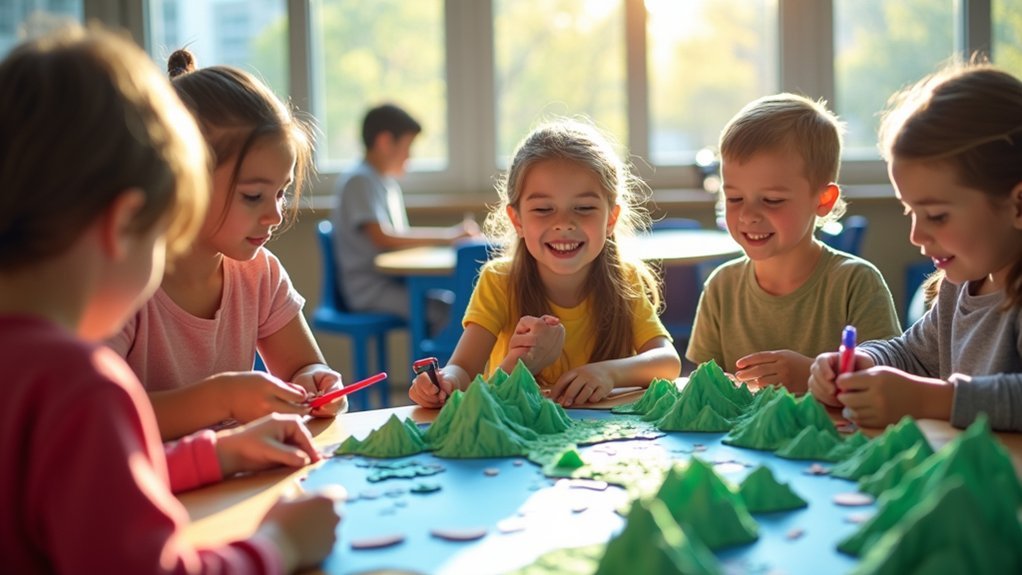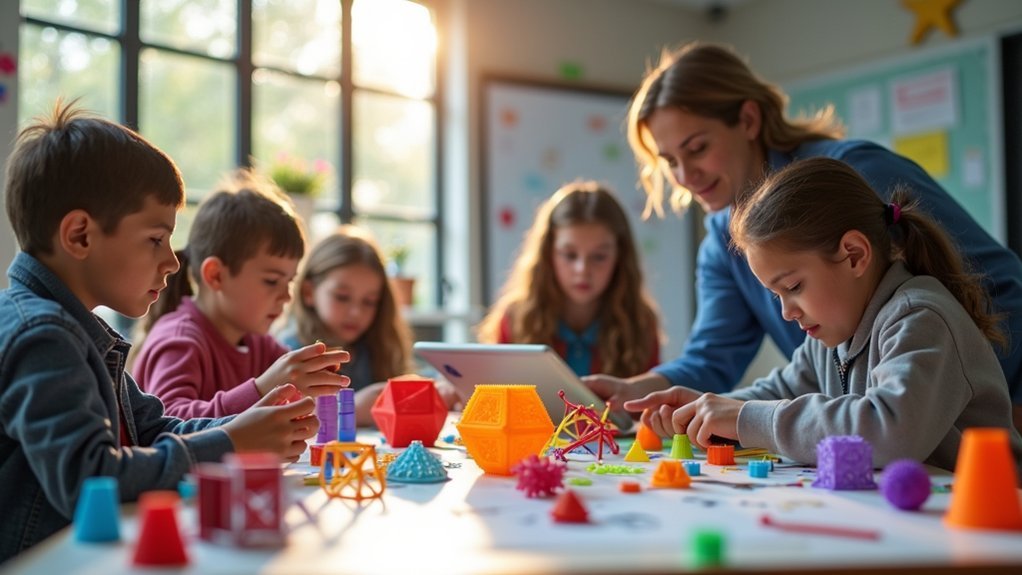You’ll engage your elementary students most effectively with these three 3D printing activities: creating interactive geography models and topographical maps that make elevation changes tangible, building historical artifacts and ancient structures that connect students to past civilizations, and designing STEM projects featuring mathematical shapes and scientific models like cells or bridges. These hands-on experiences transform abstract concepts into exciting, touchable learning tools that enhance spatial reasoning, reinforce math concepts, and foster interdisciplinary connections that’ll expand your classroom possibilities.
Creating Interactive Geography Models and Maps

When you introduce 3D printing to geography lessons, you’re transforming abstract concepts into tangible learning experiences that students can touch, explore, and understand on a deeper level.
Students can create detailed topographical maps that showcase elevation changes and geographic features, making mountainous regions and ocean depths visually comprehensible.
3D printed topographical maps transform flat geography into tactile learning experiences students can physically explore and understand.
You’ll encourage collaboration as teams design interactive models of historical landmarks, connecting cultural significance with geographical context.
This hands-on approach reinforces math concepts through measurement and geometry while students engineer their own geographical formations.
The design process develops spatial reasoning skills as students visualize three-dimensional relationships.
You’re fostering interdisciplinary learning that combines geography, engineering, and artistic representation in meaningful ways.
Building Historical Artifacts and Ancient Structures
Building on geographic exploration, you can bring historical periods to life by having students create 3D-printed replicas of ancient artifacts and architectural marvels. When students can create scaled-down versions of the Rosetta Stone or Parthenon, they develop tangible connections to past civilizations.
3D printing transforms abstract historical concepts into hands-on experiences that help students understand engineering principles behind ancient structures. The design process encourages creativity while promoting inquiry-based learning about historical context and cultural significance.
Students explore how civilizations evolved by constructing historical artifacts like ancient coins or monuments. This approach supports visual learning, making complex historical concepts accessible through interactive models.
- Watch students’ eyes light up when they hold their own Rosetta Stone replica
- Feel the excitement as young architects design their interpretation of ancient wonders
- Experience the pride students show when presenting their historical creations
Designing STEM Projects With Mathematical Shapes and Scientific Models

As students shift from historical exploration to STEM applications, 3D printing becomes a powerful tool for making abstract mathematical and scientific concepts tangible.
You’ll find that designing STEM projects with geometric shapes transforms how students understand volume, surface area, and spatial relationships. When helping students create 3D geometric models of cells, bridges, or topographical maps, they’ll develop essential engineering design skills while staying engaged.
These scientific models serve as effective math manipulatives, allowing your elementary school students to explore ratios through gear mechanisms and calculate forces in structural designs.
3D printed manipulatives transform abstract math into tangible learning experiences that elementary students can touch, explore, and truly understand.
You can create and explore endless possibilities, from plant cell organelles to bridge stability experiments. This hands-on approach keeps students engaged while reinforcing mathematical concepts through practical applications that make learning memorable and meaningful.
Frequently Asked Questions
What Type of Printer Paper Works Best for Elementary School Activities?
You’ll want 20-pound white copy paper for most activities. It’s affordable, feeds smoothly through printers, and handles crayons, markers, and pencils well. Consider cardstock for sturdier projects like bookmarks or classroom decorations.
How Can Teachers Manage Printer Costs When Doing Frequent Classroom Activities?
You’ll reduce costs by buying paper in bulk, using draft print settings, printing double-sided when possible, and creating reusable templates. Set monthly printing budgets and encourage digital alternatives for some activities.
What Safety Precautions Should Students Follow When Using Classroom Printers?
You’ll need adult supervision when operating printers. Don’t touch moving parts or paper jams. Keep fingers away from the paper path. Always turn off the printer before cleaning, and never force stuck paper out yourself.
How Do You Troubleshoot Common Printer Problems During Class Time?
When you’re troubleshooting printer issues, first check if it’s plugged in and has paper. Restart the printer, clear any paper jams, and verify ink cartridges aren’t empty. Keep spare supplies nearby for quick fixes.
What Are Age-Appropriate Printer Activities for Different Elementary Grade Levels?
You’ll want kindergarteners printing their names and simple pictures. First-graders can handle basic worksheets and coloring pages. Older elementary students should print research projects, creative stories, and formatting practice documents.





Leave a Reply